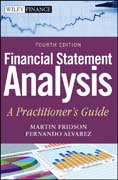
Financial statement analysis: a practitioner's guide
Fridson, Martin S.
Alvarez, Fernando
An updated guide to the essential discipline of financial statement analysis In Financial Statement Analysis, Fourth Edition, leading investment authority Martin Fridson returns with Fernando Alvarez to provide the analytical framework you need to scrutinize financial statements, whether you're evaluating a company's stock price or determining valuations for a merger or acquisition. This fully revised and up-to-date Fourth Edition offers fresh information that will help you to evaluate financial statements in today's volatile markets and uncertain economy, and allow you to get past the sometimes biased portrait of acompany's performance. Reflects changes in the financial reporting landscape,including issues related to the financial crisis of 2008-2009 Provides guidelines on how to interpret balance sheets, income statements, and cash flow statements Offers information for maximizing the accuracy of forecasts and a structured approach to credit and equity evaluation Filled with real-life examples and expert advice, Financial Statement Analysis, Fourth Edition will help you gain a firm understanding of the techniques that will help you interpret financial statements, which are designed to conceal more than reveal. INDICE: Preface. Acknowledgments. Part I: Reading between the Lines. Chapter 1: The Adversarial Nature of Financial Reporting. The Purpose of Financial Reporting. The Flaws in the Reasoning. Small Profits and Big Baths. MaximizingGrowth Expectations. Downplaying Contingencies. The Importance of Being Skeptical. Conclusion. Part II: The Basic Financial Statements. Chapter 2: The Balance Sheet. The Value Problem. Comparability Problems in the Valuation of Financial Assets. Instantaneous Wipeout of Value. How Good Is Goodwill? Losing Value the Old-Fashioned Way. True Equity Is Elusive. Pros and Cons of a Market-Based Equity Figure. The Common Form Balance Sheet. Conclusion. Chapter 3: The Income Statement. Making the Numbers Talk. How Real Are the Numbers? Conclusion.Chapter 4: The Statement of Cash Flows. The Cash Flow Statement and the LBO. Analytical Applications. Cash Flow and the Company Life Cycle. The Concept of Financial Flexibility. In Defense of Slack. Conclusion. Part III: A Closer Look at Profits. Chapter 5: What Is Profit? Bona Fide Profits versus Accounting Profits. What Is Revenue? Which Costs Count? How Far Can the Concept Be Stretched? Conclusion. Chapter 6: Revenue Recognition. Channel-Stuffing in the Drug Business. A Second Take on Earnings. Astray on Layaway. Recognizing Membership Fees. A Potpourri of Liberal Revenue Recognition Techniques. Fattening Earnings with Empty Calories. Tardy Disclosure at Halliburton. Managing Earnings withRainy Day Reserves. Fudging the Numbers: A Systematic Problem. Conclusion. Chapter 7: Expense Recognition. Nortel's Deferred Profit Plan. Grasping for Earnings at GM. Time-Shifting at Freddie Mac. Conclusion. Chapter 8: The Applications and Limitations of EBITDA. EBIT, EBITDA, and Total Enterprise Value. The Role of EBITDA in Credit Analysis. Abusing EBITDA. A More Comprehensive Cash Flow Measure. Working Capital Adds Punch to Cash Flow Analysis. Conclusion. Chapter 9: The Reliability of Disclosure and Audits. An Artful Deal. Death Duties.Systematic Problems in Auditing. Conclusion. Chapter 10: Mergers-and-Acquisitions Accounting. Maximizing Postacquisition Reported Earnings. Managing Acquisition Dates and Avoiding Restatements. Conclusion. Chapter 11: Is Fraud Detectable? Telltale Signs of Manipulation. Fraudsters Know Few Limits. Enron: A Media Sensation. HealthSouth's Excruciating Ordeal. Milk and Other Liquid Assets.Conclusion. Part IV: Forecasts and Security Analysis. Chapter 12: ForecastingFinancial Statements. A Typical One-Year Projection. Sensitivity Analysis with Projected Financial Statements. Projecting Financial Flexibility. Pro Forma Financial Statements. Pro Forma Statements for Acquisitions. Multiyear Projections. Conclusion. Chapter 13: Credit Analysis. Balance Sheet Ratios. Income Statement Ratios. Statement of Cash Flows Ratios. Combination Ratios. Relating Ratios to Credit Risk. Conclusion. Chapter 14: Equity Analysis. The Dividend Discount Model. The Price-Earnings Ratio. Why P
- ISBN: 978-0-470-63560-5
- Editorial: John Wiley & Sons
- Encuadernacion: Cartoné
- Páginas: 400
- Fecha Publicación: 15/06/2011
- Nº Volúmenes: 1
- Idioma: Inglés
